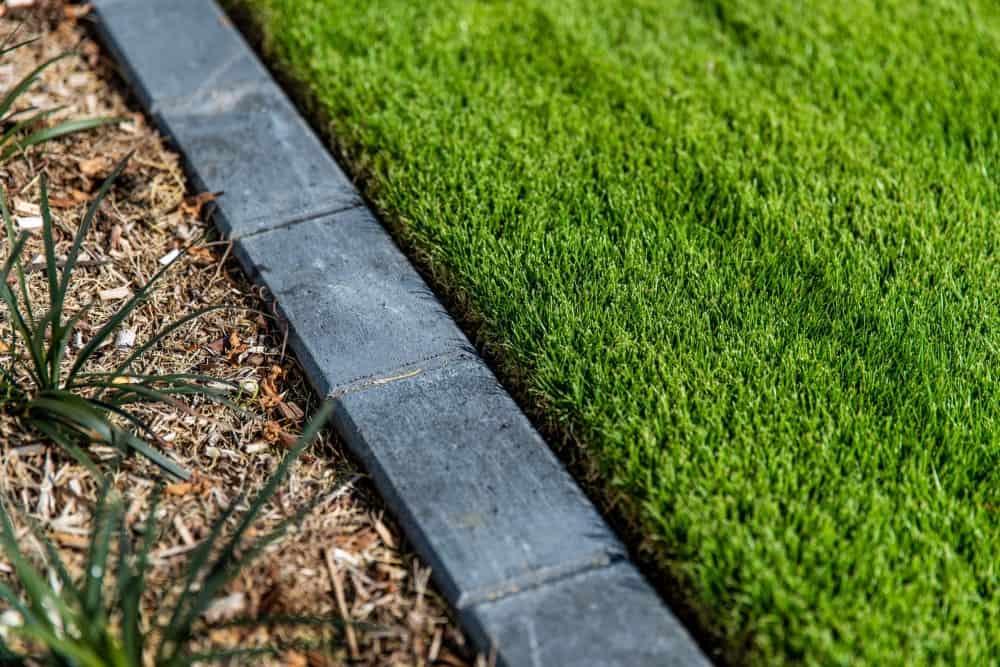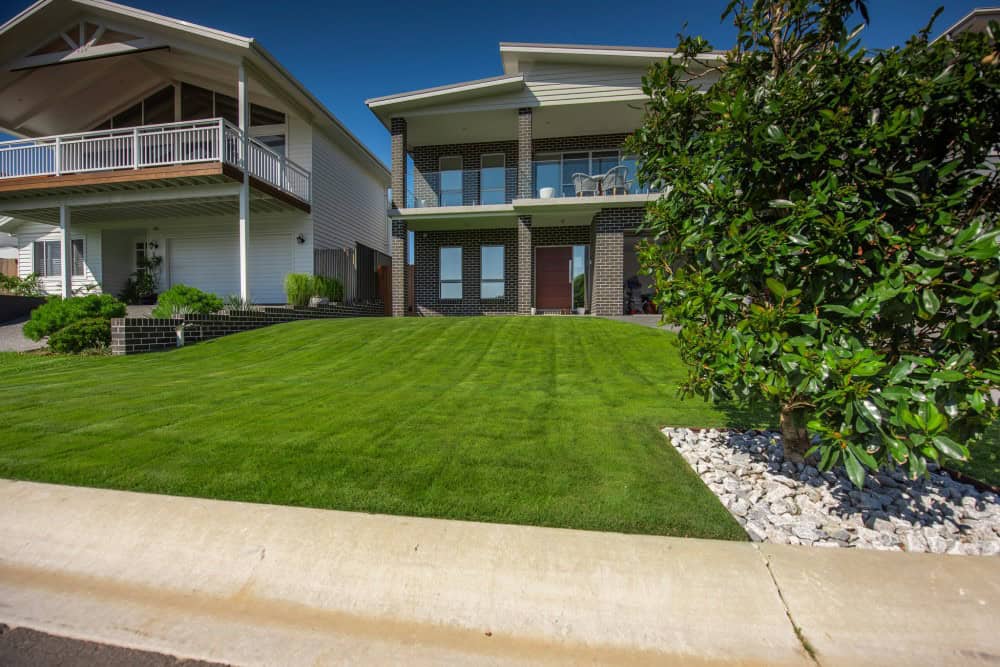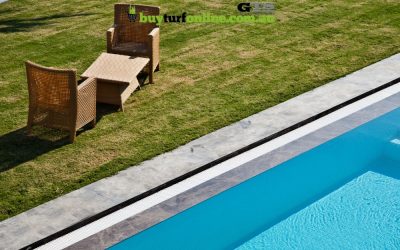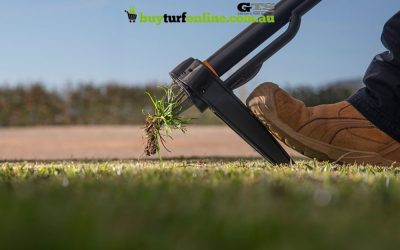Sir Grange Zoysia Fertiliser
Does Your Sir Grange Need a Fertilser?
Maintaining a lush, green lawn requires more than just regular watering and mowing – fertilising your grass is a key part of lawn care.
This is especially true for Sir Grange Zoysia lawns. A premium turf known for its fine texture and low-maintenance qualities, the fertilisation practices are slightly different to other lawn varieties.
In this guide, we’ll dive into the specifics of fertilising Sir Grange Zoysia, including what fertiliser to use, when to apply it, and how to ensure your lawn remains healthy and vibrant throughout the year.
What is Sir Grange Zoysia?
Before we dive into how to fertilise a Sir Grange lawn, it’s important to understand what sets this lawn apart from others.
Sir Grange Zoysia grass qualities
Sir Grange Zoysia is a standout variety of Zoysia grass.
It’s prized for its durability, fine leaf texture, and deep green hue. Originating from the Zoysia matrella species, Sir Grange is renowned for its low maintenance requirements, making it an ideal choice for homeowners seeking a premium lawn with minimal upkeep.
This grass is slow-growing, drought-tolerant, and capable of thriving in a variety of soil types, making it both resilient and beautiful.
[Find out more about Sir Grange turf]
One of the key advantages of Sir Grange Zoysia is its reduced need for fertilisation.
Compared to other turf varieties, it requires only a third of the fertiliser, thanks to its efficient nutrient uptake and slow growth.
This characteristic not only saves time and resources but also contributes to the overall health of the lawn by reducing the risk of over-fertilisation.
The Best Type of Fertiliser for Sir Grange Lawns
When it comes to maintaining the pristine condition of your Sir Grange Zoysia lawn, choosing the right type of fertiliser is crucial.
Given the unique characteristics of this grass variety, not just any fertiliser will do. Here’s what you need to know about selecting the best fertiliser for Sir Grange Zoysia.
The nutritional needs of Sir Grange Zoysia lawn
Sir Grange Zoysia, like all plants, requires a balanced supply of nutrients to thrive. The key nutrients are nitrogen (N), phosphorus (P), and potassium (K), each playing a vital role in the health of your lawn.
Nitrogen (N)
Promotes lush, green growth but should be used sparingly with Sir Grange due to its low nutrient requirements.
Phosphorus (P)
Essential for root development, particularly important during the establishment phase.
Potassium (K)
Strengthens the grass’s resistance to disease, drought, and stress.
Given Sir Grange’s slow growth and low nutrient needs, it’s crucial to apply fertiliser only when the lawn shows signs of nutrient deficiency, such as loss of colour.
Over-fertilisation can lead to excessive thatch build-up and increase the frequency of mowing, which runs counter to the low-maintenance appeal of Sir Grange Zoysia.
Slow-release granular fertilisers
For Sir Grange Zoysia, slow-release granular fertilisers are generally the best option. These fertilisers gradually release nutrients over time, aligning with the slow growth rate of Sir Grange.
This gradual release prevents nutrient overload, reducing the risk of fertiliser burn and excessive thatch build-up.
Slow-release fertilisers give a steady supply of nutrients that mimics the natural feeding rhythm of Sir Grange, ensuring consistent growth and maintaining the grass’s vibrant green colour.
Unlike quick-release fertilisers, which can deliver a surge of nutrients that the grass may not fully utilise, slow-release options provide a balanced and sustained feed that supports the grass’s health without encouraging rapid, unwanted growth.
Fertiliser recommendations for Sir Grange Zoysia
Choosing the right product is essential to achieving the best results for your Sir Grange lawn. Based on the growth habit and nutrient needs of Sir Grange Zoysia grass, we recommend the following fertilisers.
Lawn Solutions Premium Fertiliser
This fertiliser is specifically designed to meet the nutritional needs of premium turf varieties like Sir Grange Zoysia.
With a balanced NPK ratio and slow-release formulation, it provides a steady supply of nutrients without overwhelming the grass.
To apply this fertiliser on Sir Grange lawns, use 25% of the label rate as Sir Grange requires significantly less fertiliser than other grass types.
Apply in early Spring and again in mid to late Summer if needed, always following up with thorough watering to ensure the nutrients reach the roots.
Sir Launcher
Sir Launcher is perfect for giving your lawn a boost when you’re installing Sir Grange for the first time.
Not only will Sir Launcher encourage strong root development, but it contains moisture magnets so you require less water to establish Sir Grange turf.
This is especially important before laying the turf to prepare the soil and support the new grass as it establishes itself.
Follow the product’s instructions carefully, ensuring that the fertiliser is evenly distributed in the soil and watered in thoroughly before your Sir Grange turf is laid.
When to Fertilise Your Sir Grange Lawn
Timing is crucial when it comes to fertilising Sir Grange Zoysia. Here’s a seasonal guide to help you get it right.
Spring
As Sir Grange begins to emerge from dormancy, a light application of fertiliser can help kickstart growth. This is the ideal time to provide the nutrients needed for a strong growing season.
Summer
Another application in mid to late summer can support the lawn during peak growth periods, especially if the grass shows signs of nutrient deficiency.
Autumn and Winter
Avoid fertilising during these seasons, as Sir Grange enters dormancy and does not require additional nutrients.
However, applying ColourGuard PLUS can help maintain the lawn’s appearance without overfertilising.
Repairing your lawn
As well as your seasonal fertilising, you may also need to give your lawn a boost to help repair bare patches or damage. For a quick pick-me-up, a liquid fertiliser is a great choice.
Find out more about how to repair Sir Grange Zoysia grass in our guide.
How to Apply Fertiliser to Sir Grange Zoysia
Proper application techniques are vital to ensure that your Sir Grange Zoysia lawn benefits fully from fertilisation.
Preparation
Make sure you haven’t recently mowed your lawn and ensure it is free of debris before fertilising. This means your lawn won’t already be under stress and the fertiliser won’t negatively affect your lawn.
Application
Use a spreader to ensure even distribution of granular fertilisers. If using liquid fertilisers, apply them evenly using a spray applicator.
Post-fertilisation care
Water the lawn immediately after fertilising to help the nutrients penetrate the soil and prevent leaf burn. Avoid mowing for at least a week after fertilisation to allow the nutrients to be absorbed fully.
Common Issues with Sir Grange Zoysia Fertilisation
Even with the best intentions, mistakes happen. Here are some common issues to watch out for when fertilising your Sir Grange Zoysia grass.
Fertiliser burn
Caused by over-application, this can damage the grass and lead to unsightly patches. Prevent this by following the recommended application rates and watering thoroughly after fertilising.
Thatch build-up
Over-fertilising can lead to excessive thatch, making the lawn harder to maintain. Stick to the minimal fertilisation approach recommended for Sir Grange.
Mowing too soon
Cutting the grass too soon after fertilisation can hinder the absorption of nutrients. Always wait at least a week before mowing.
Selecting the right fertiliser is key to unlocking the full potential of your Sir Grange Zoysia lawn.
By choosing a slow-release granular fertiliser with an appropriate NPK ratio and applying it correctly, you’ll be investing in the long-term health and beauty of your lawn.
Always remember that less is more when it comes to fertilising Sir Grange, and by following these guidelines, you can enjoy a lush, green lawn with minimal effort year-round.
read more!
recent posts
Poolside Turf: Choosing and Maintaining Grass Around Pools
There’s nothing quite like stepping out of a swimming pool onto soft, lush grass. But when it comes to finding the best grass for around a pool, not all lawns are created equal. Chlorine pools, heavy foot traffic, and the unforgiving Australian sun can take a toll on...
Keeping Your Lawn Green and Healthy During the Summer Heat
Discover the best grass options for your lawn with our complete guide. Make informed choices for a lush, healthy yard. Read more to find your ideal grass!
Summer Lawn Weeds: Prevention and Management
Discover the best grass options for your lawn with our complete guide. Make informed choices for a lush, healthy yard. Read more to find your ideal grass!

Our Turf
TifTuf Bermuda
Buy Turf Online © 2019 All Rights Reserved. | Proudly Designed and Developed by Sydney ICT





